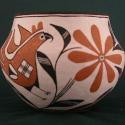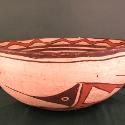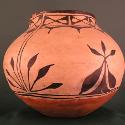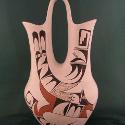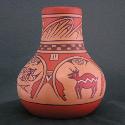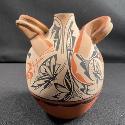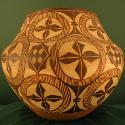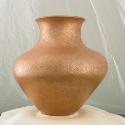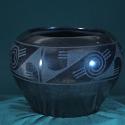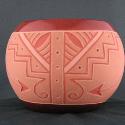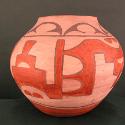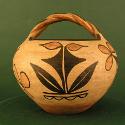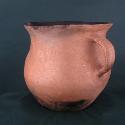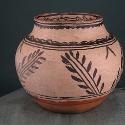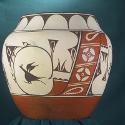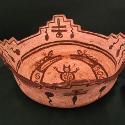About the pueblos
The term "Pueblo" is actually a spanish word. meaning "village," given to a distinct cultural group in the southwestern United States.
The valley of the Rio Grande, between Taos, Santa Fe and Albuquerque, contains 17 villages. These are home to 24,000 Native Americans. A common culture with individual variances connected them to a degree, though there were four separate language groups: Keres, Tanoa, Hopi and Zuni. Tanoa is further divided into three subgroups: Tewa, Tiwa and Towa.
The Ancestral Puebloans
The peoples who formed the Pueblo communities are the descendants of the prehistoric Ancestral Puebloans, the "Ancient People" who inhabited the famous ancient pueblos at Chaco Canyon, Aztec and Mesa Verde. These Ancestral Puebloan pueblos are estimated to have begun approximately 10,000 years ago and then for unknown reasons were abandoned in the 13th and 14th centuries.
The Pueblo People live in permanent villages, constructed of stone and adobe. Traditionally they were located atop mesas, to provide them with security and a strong defensive position to withstand raids by other tribes. Although the geographical lines are not definite, there is a shift of organization and beliefs as one moves from the Western Pueblos of Arizona (Hopi) to east the Eastern Pueblos of New Mexico (Taos).
Theories also state that between 1400 and 1525 C.E. the Athabascans, the ancestors of the current Apache and Navajo tribes come into the Southwest area.
After the Spanish contact of the 16th century there were considerable changes in the relatively conservative Pueblo culture. In 1540 Francisco Vasquez de Coronado reached Zuni pueblo and later entered Taos and Pecos. This is generally considered the beginning of the historic period in the region. By 1600 the Spanish began to settle in the area of present-day New Mexico, building Mission Churches and military forts. Unrest among the subjugated Pueblos was intermittent, with alternating peace and strife.
Santa Fe was founded in 1610, and from this settlement, conversion of the Pueblos was organized on a larger scale. The Spanish introduced horses, beef cattle, goat, sheep and other livestock. New crops, such as wheat, were also to create changes in the Pueblo way of life. Unfortunately, European contact brought numerous diseases to which Native Americans had little or no resistance. Some villages lost as much as 80% of their people.
The Spanish priests in their attempts to convert the Native Americans to Christianity outlawed many of the traditional sacred ceremonies. Many traditions continued in secret, but the medicine men were defined as enemies and the religion of the Pueblos was suppressed almost to extinction.
Outraged, the Pueblos organized a revolt in 1680 that successfully drove out the Spanish. 12 years later the Spanish returned with a larger army and accomplished a campaign of reconquest that put down any further revolts until 1736. There were further rebellions due to the religious conversions and mandatory service to the Spanish landowners, though none on as large a scale as the revolt of 1680.
Mexico gained its independence from Spain in 1821. It would govern New Mexico for the next 25 years. During this period several of the nomadic tribes of the area took advantage of the Mexican government’s neglect of the area to intensify their raids.
In 1846 war broke out between Mexico and the United States. When the war ended in 1848, the Treaty of Guadalupe Hidalgo was signed which ceded the present New Mexico and southern California areas to the United States. Raids declined, resulting in a relatively peaceful time in the area.
However, continuous settlement of Pueblo lands occurred, mainly by settlers migrating from the north and east. This was also the era of the decimation of the buffalo, which caused great suffering to the tribes of the Great Plains who depended upon them for much of their subsistence. The prosperity of many of the pueblo villages depended on trade with these northern tribes.
Over the years, laws were passed which slowly eroded the traditions of the Native Americans both of the Southwest and all over the country. The government did little to enforce the treaties of the area, effectively reducing what were once quite large pueblo land areas to what is left today.
In the 1950’s a renewal of Pueblo culture began. The American public was beginning to take interest in the Puebloan cultures because of their artistic creativity. Southwestern pottery and Jewelry became important factors in their economic development. Many artists have become known far outside of the Southwest. Maria Martinez, from San Ildefonso, has achieved renowned fame for her black and polychrome pottery. Living conditions also improved, as well as population. There has been a growing awareness of native identity, and the Pueblo has managed to maintain their traditions and ceremonies in the face of social change.
Though the land is relatively unchanged from the times of the first European contact with the Pueblos, the world around them has changed considerably. The art of the Pueblos has changed because of influence and commercial demands of the outside world. Most pottery, jewelry and textiles are now made to sell and not for local consumption. In Pueblos such as Acoma, the manufacturing and selling of these objects have had a great influence on the pueblos economy and development. Other pueblos such as Santa Ana have maintained their isolation and have not developed their arts as an important source of income.
Further Readings
Sando, Joe S. Pueblo Nations: Eight Centuries Of Pueblo Indian History
Acatos, Sylvio Pueblos: Prehistoric Indian Cultures of the Southwest


